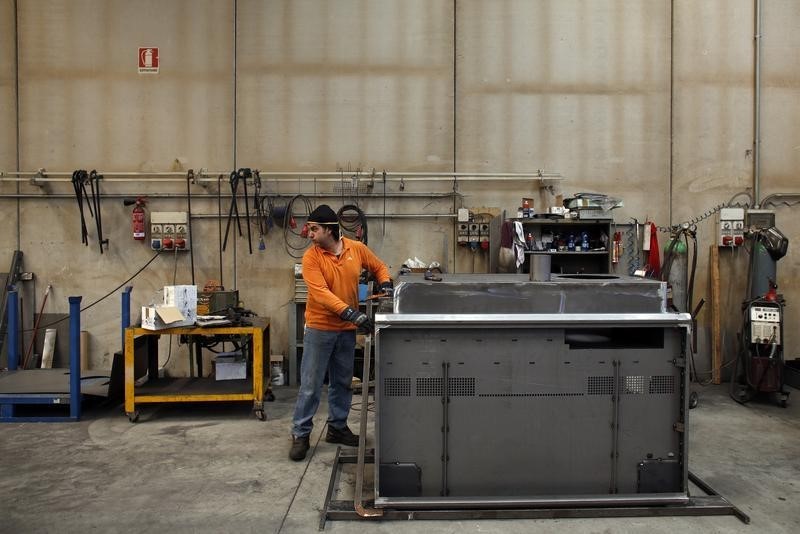Investing.com — The idea of a U.S. manufacturing resurgence has been a prominent topic in political discussions in recent years, with promises of reviving the industrial strength that once characterized the American economy.
Both the Trump and Biden administrations have introduced ambitious initiatives aimed at reshoring manufacturing, including tariffs, tax incentives, and substantial government investments, said analysts at Alpine Macro.
U.S. manufacturing has been in gradual decline for decades. In the early 1970s, manufacturing value added made up 23% of GDP, but today it stands at around 10%.
While a few key sectors have helped lift overall figures, median output across sub-industries has fallen by 20%.
This indicates that, rather than a broad recovery, the modest increases in output are concentrated in a small number of industries, such as semiconductors, leaving much of the manufacturing sector stagnant.
“In terms of employment, the secular drop in manufacturing payrolls has continued, although there has been a gain of 1.5 million manufacturing jobs since 2010,” the analysts said, this recovery is small in comparison to the 6 million manufacturing jobs lost in the 2000s.
With manufacturing jobs now making up just 8% of the workforce, the sector’s long-term decline continues, raising questions about claims of an industrial revival.
While there has been an increase in manufacturing investment, it has been restricted to specific industries like semiconductors. Overall capital investment in manufacturing has stagnated, with fixed asset formation flat for decades.
Capital outlays on equipment, which once accounted for 8% of GDP in the 1980s, have dwindled to a mere 5%. This slowdown in capital accumulation is closely tied to diminishing productivity in the sector, further undermining any claims of a renaissance.
In fact, Alpine Macro’s data show that productivity growth within manufacturing continues to lag behind other segments of the U.S. economy, making it unlikely that the sector will experience a broad-based recovery
The structural challenges facing U.S. manufacturing extend far beyond investment and productivity. As economies evolve, the transition from industrial-based growth to service-driven economies is inevitable.
Wealthier societies tend to shift their consumption patterns away from goods and toward services, diminishing the overall importance of manufacturing.
Even China, often regarded as the world’s manufacturing powerhouse, has seen a decline in its manufacturing share of GDP since 2008.
This broader economic shift renders attempts to re-industrialize the U.S. not only difficult but also largely counterproductive.
High-income countries like the U.S. would need to rely heavily on exporting manufactured goods to achieve any meaningful manufacturing expansion, a model that has not resulted in higher income growth for other industrial giants like Germany and Japan
One of the most significant hurdles to a U.S. manufacturing revival is the country’s high labor costs. American workers are about 70% more productive than their Chinese counterparts, yet they earn six times the wages.
This disparity makes it nearly impossible for U.S. companies to compete in labor-intensive industries, regardless of how efficient their operations may be.
As a result, the U.S. manufacturing sector remains concentrated in high-value, specialized industries such as aerospace, advanced machinery, and medical devices, while industries requiring more labor have increasingly shifted operations to lower-cost countries like Vietnam and Cambodia
Alpine Macro flags that much of the rhetoric surrounding a manufacturing renaissance is driven more by political motivations than economic realities.
The promises of revitalizing domestic manufacturing play well in swing states like those in the Rust Belt, where industrial job losses have taken a significant toll on communities.
However, policies aimed at reversing these trends, such as the Biden administration’s Inflation Reduction Act (IRA) or Trump’s tariffs on Chinese imports, have failed to deliver meaningful results.
While the IRA has spurred nearly $400 billion in investment, these efforts have been narrowly focused on semiconductors, with other critical sectors, such as electric vehicles and green energy technologies, seeing little benefit
Further complicating the situation is a lack of skilled labor to meet the potential demand in advanced manufacturing.
The pipeline of new workers is insufficient, and the manufacturing workforce continues to age, with those under 25 comprising only 9% of the sector, compared to 13% across all other industries.
Moreover, bureaucratic red tape has caused significant delays in many of the large-scale investments planned under the IRA, casting further doubt on the policy’s long-term impact
From a market perspective, Alpine Macro underscores the lack of tangible benefits for industrial stocks. The sector continues to underperform, reflecting the broader productivity stagnation in manufacturing.
Although government subsidies have boosted the U.S. chip sector, the tightening of export controls, particularly those targeting China, threatens to erode these gains.
“In 2021, China accounted for $18 billion, or about 23%, of U.S. semiconductor and circuit-related exports,” the analysts said. In the long run, China’s increasing self-sufficiency in low-end semiconductor production could intensify competition and limit growth opportunities for U.S. firms
While the U.S. onshoring narrative remains politically charged, a more significant trend is emerging: the rise of “friend-shoring.”
U.S. companies are increasingly relocating production to countries with similar wage levels and economic complexities as China, but with less geopolitical risk.
Nations like Vietnam, Malaysia, Mexico, and India are poised to benefit from this trend as companies shift away from China in response to escalating tensions between Washington and Beijing.
For investors, this presents new opportunities as global supply chains realign, even as the vision of a domestic manufacturing revival in the U.S. fades further into the distance

